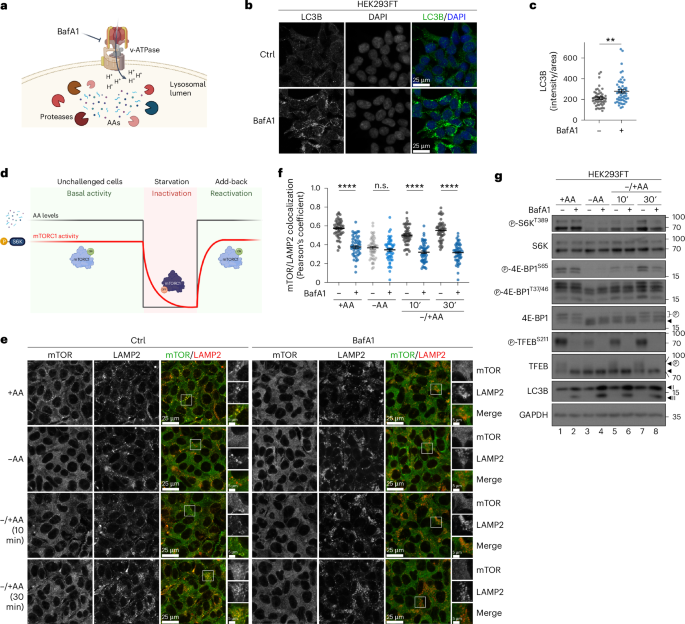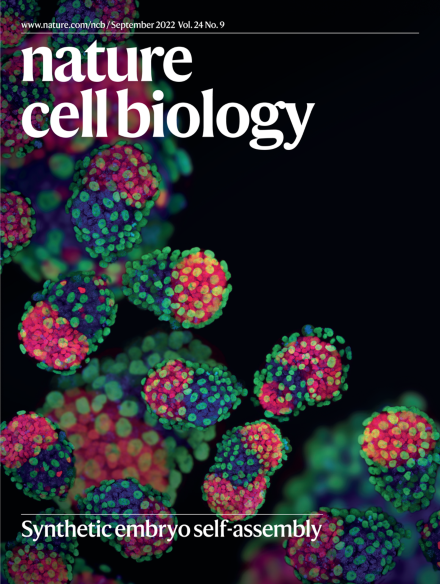Spatial and functional separation of mTORC1 signalling in response to different amino acid sources
IF 17.3
1区 生物学
Q1 CELL BIOLOGY
引用次数: 0
Abstract
Amino acid (AA) availability is a robust determinant of cell growth through controlling mechanistic/mammalian target of rapamycin complex 1 (mTORC1) activity. According to the predominant model in the field, AA sufficiency drives the recruitment and activation of mTORC1 on the lysosomal surface by the heterodimeric Rag GTPases, from where it coordinates the majority of cellular processes. Importantly, however, the teleonomy of the proposed lysosomal regulation of mTORC1 and where mTORC1 acts on its effector proteins remain enigmatic. Here, by using multiple pharmacological and genetic means to perturb the lysosomal AA-sensing and protein recycling machineries, we describe the spatial separation of mTORC1 regulation and downstream functions in mammalian cells, with lysosomal and non-lysosomal mTORC1 phosphorylating distinct substrates in response to different AA sources. Moreover, we reveal that a fraction of mTOR localizes at lysosomes owing to basal lysosomal proteolysis that locally supplies new AAs, even in cells grown in the presence of extracellular nutrients, whereas cytoplasmic mTORC1 is regulated by exogenous AAs. Overall, our study substantially expands our knowledge about the topology of mTORC1 regulation by AAs and hints at the existence of distinct, Rag- and lysosome-independent mechanisms that control its activity at other subcellular locations. Given the importance of mTORC1 signalling and AA sensing for human ageing and disease, our findings will probably pave the way towards the identification of function-specific mTORC1 regulators and thus highlight more effective targets for drug discovery against conditions with dysregulated mTORC1 activity in the future. Fernandes, Angelidaki et al. provide evidence supporting the spatial separation of mTORC1 activation and signalling. Differentially localized mTORC1 complexes phosphorylate distinct substrates in response to different amino acid supplies.


mTORC1 信号对不同氨基酸源的响应在空间和功能上的分离
氨基酸(AA)的可用性通过控制雷帕霉素复合体 1(mTORC1)的机理/哺乳动物靶标活性而成为细胞生长的有力决定因素。根据该领域的主流模型,AA 的充足性会通过异源二聚体 Rag GTP 酶驱动 mTORC1 在溶酶体表面的招募和激活,并从那里协调大多数细胞过程。然而,重要的是,溶酶体对 mTORC1 的调控机制以及 mTORC1 在何处作用于其效应蛋白仍然是个谜。在这里,我们利用多种药理学和遗传学手段来扰乱溶酶体AA传感和蛋白质循环机制,描述了哺乳动物细胞中mTORC1调控和下游功能的空间分离,溶酶体和非溶酶体mTORC1在不同的AA来源下磷酸化不同的底物。此外,我们还发现,即使细胞在有细胞外营养物质存在的情况下生长,由于溶酶体的基础蛋白水解会在局部提供新的 AA,因此一部分 mTOR 会定位在溶酶体,而细胞质中的 mTORC1 则受外源 AA 的调控。总之,我们的研究大大拓宽了我们对mTORC1受AAs调控的拓扑结构的认识,并暗示了存在不同的、依赖于Rag和溶酶体的机制来控制其在其他亚细胞位置的活性。鉴于 mTORC1 信号传导和 AA 传感对人类衰老和疾病的重要性,我们的研究结果很可能会为鉴定功能特异性 mTORC1 调节因子铺平道路,从而为将来发现治疗 mTORC1 活性失调疾病的药物找到更有效的靶点。
本文章由计算机程序翻译,如有差异,请以英文原文为准。
求助全文
约1分钟内获得全文
求助全文
来源期刊

Nature Cell Biology
生物-细胞生物学
CiteScore
28.40
自引率
0.90%
发文量
219
审稿时长
3 months
期刊介绍:
Nature Cell Biology, a prestigious journal, upholds a commitment to publishing papers of the highest quality across all areas of cell biology, with a particular focus on elucidating mechanisms underlying fundamental cell biological processes. The journal's broad scope encompasses various areas of interest, including but not limited to:
-Autophagy
-Cancer biology
-Cell adhesion and migration
-Cell cycle and growth
-Cell death
-Chromatin and epigenetics
-Cytoskeletal dynamics
-Developmental biology
-DNA replication and repair
-Mechanisms of human disease
-Mechanobiology
-Membrane traffic and dynamics
-Metabolism
-Nuclear organization and dynamics
-Organelle biology
-Proteolysis and quality control
-RNA biology
-Signal transduction
-Stem cell biology
 求助内容:
求助内容: 应助结果提醒方式:
应助结果提醒方式:


